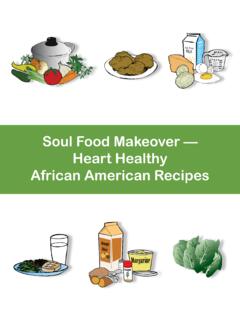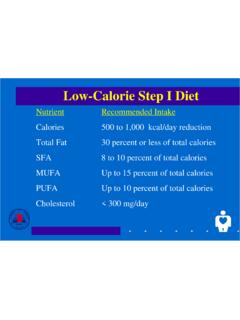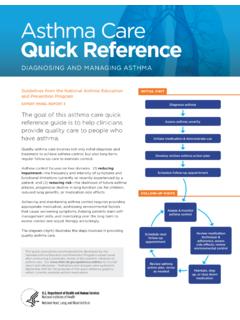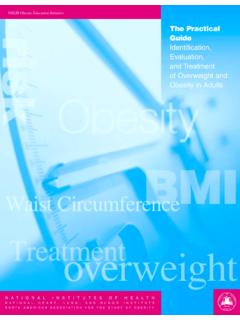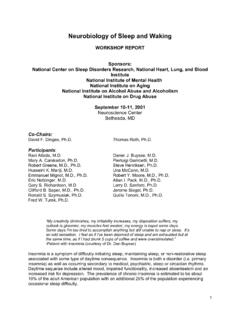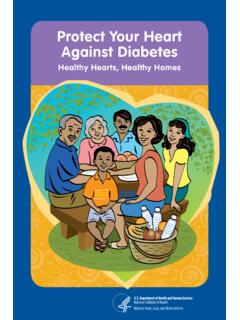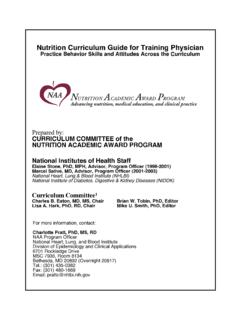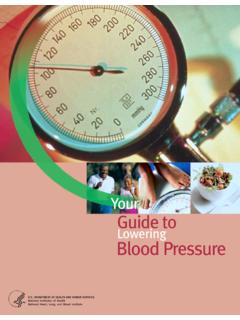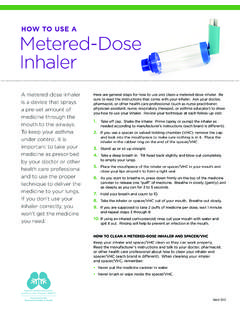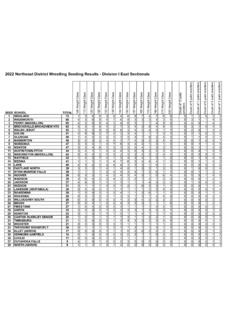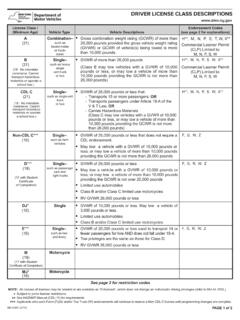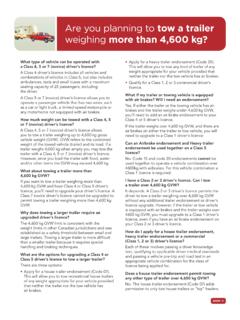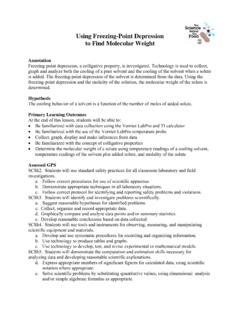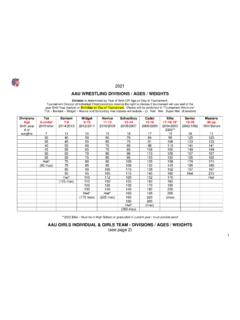Transcription of Facts About Healthy Weight - National Institutes of Health
1 Why Is a Healthy WeightImportant?Being overweight or obese increasesyour risk for many diseases and condi-tions. The more you weigh, the morelikely you are to suffer from heart dis-ease, high blood pressure, diabetes,gallbladder disease, sleep apnea, andcertain cancers. On the other hand, ahealthy Weight has many benefits: Ithelps you to lower your risk for devel-oping these problems, helps you to feelgood About yourself, and gives youmore energy to enjoy Is Your Risk forWeight-Related Diseases?Body Mass Index (BMI)Your BMI accurately estimates yourtotal body fat. And, the amount of fatthat you carry is a good indicator ofyour risk for a variety of are two ways to check your BMI: Use the BMI chart on page , find your height in the left-hand column. Then, follow it over until you find your number on the top of thatcolumn is your BMI. Use the BMI calculator on theNational Heart, Lung, and BloodInstitute s (NHLBI s) Web site: you know your BMI, checkBox 1 to see what the number BMI can be used for mostmen and women, it does have somelimitations: It may overestimatebody fat inathletes and others who have amuscular tips for Weight loss success: Set specific, realistic goals that areforgiving (less than perfect).
2 Tostart, try walking 30 minutes,3 days a week. Ask for encouragement fromyour Health care provider(s) viatelephone or e-mail; friends andfamily can help. You can alsojoin a support group. Keep a record of your food intakeand the amount of physical activi-ty that you do. This is an easy wayto track how you are doing. Arecord can also inspire you. Forexample, when it shows thatyou ve been more active, you ll beencouraged to keep it up. Change your surroundings to avoidovereating. For example, don t eatwhile watching television. Plan tomeet a friend in a nonfood setting. Reward your success but not withfood. Instead, choose rewards thatyou ll enjoy, such as a movie,music CD, an afternoon off fromwork, a massage, or personal Learn More Contact NHLBI for information onweight management and heart Health :NHLBI Health Information Box 30105 Bethesda, MD 20824 0105 Phone: 301 592 8573 TTY: 240 629 3255 Fax: 301 592 8563 Also, check out these Web sites andWeb pages:NHLBI: publications and interactivefeatures on overweight and obesity,high blood pressure, high blood cho-lesterol, heart attack, asthma, andwomen s heart Health Aim for a Healthy Weight : publications and suchinteractive features as a PortionDistortion quiz and BMI calculator We Can!
3 Ways to EnhanceChildren s Activity and Nutrition: materials for parents to helpprevent overweight and obesity intheir children Heart Healthy Recipes: can feel healthier by doing any of the following activities. For addedfun, ask friends or family to join you. Walk or ride a bike in your neighborhood. Join a walking club at a mall or at work. Play golf at a local club. Join a dance or yoga class. Work in your garden. Use local athletic facilities. Join a hiking or biking club. Join a softball team or play othersports with coworkers, friends, andfamily. It may underestimatebody fat inolder persons and others whohave lost CircumferenceMeasurementYour waist circumference is also animportant measurement to help youfigure out your overall Health most of your fat is around yourwaist, then you are more at risk forheart disease and diabetes. This riskincreases with a waist measurementthat is: Greater than 35 inches for women Greater than 40 inches for men Other Risk Factors for HeartDiseaseIf you have other risk factors forheart disease (shown in Box 2) andare overweight or obese, then youwill be at greater risk for healthproblems.
4 Your doctor will checkyour BMI, waist circumference, andother risk factors for heart disease: If you are overweight (BMI 25 ),do not have a high waist circum-ference, and have less than tworisk factors, then it s importantthat you not gainany moreweight. If you are overweight (BMI 25 )or have a high waist circumferenceand have two or more risk factors,then it is important for you to loseweight. If you are obese (BMI 30), thenit is important for you to a small Weight loss (just 5 10percent of your current Weight ) willhelp to lower your risk of developingweight-related i g h DEPARTMENT OF Health AND HUMAN SERVICESN ational Institutes of Health National Heart, Lung, and Blood DEPARTMENT OF Health AND HUMAN SERVICESN ational Institutes of Health National Heart, Lung, and Blood InstituteNIH Publication No. 06-5830 June 2006diets of less than 800 calories per dayshould not be used unless you arebeing monitored by your ActivityStaying physically active and eatingfewer calories will help you loseweight and keep the Weight off overtime.
5 Plus, physical activity hasmany benefits: Lowers the risk of heart disease;diabetes; and such cancers asbreast, uterus, and colon Strengthens your lungs and helpsthem to work more efficiently Strengthens your muscles andkeeps your joints in good condition May slow bone loss Gives you more energy Helps you to relax and cope betterwith stress Builds confidence Allows you to fall asleep morequickly and sleep more soundly Provides an enjoyable way to sharetime with friends and familyHow much physical activity shouldyou aim for? For overall Health and to reducethe risk of disease, aim for at least30 minutes of moderate physicalactivity most days of the To Lose Weight andMaintain ItChanging the way you approachweight loss can help you be more suc-cessful at losing it. Most people whotry to lose Weight focus on one thing: Weight loss. However if you set goals,begin to eat Healthy foods, becomemore physically active, and learn howto change behaviors, then you maybe more successful at losing time, these changes will becomeroutine and part of your everyday Loss GoalsSetting the right goals is an impor-tant first step to losing and maintain-ing Weight .
6 Losing just 5 10 percent of yourcurrent Weight over 6 months willlower your risk for heart diseaseand other conditions. Losing 1 2 pounds per week is areasonable and safe Weight Weight at this rate will helpyou to keep off the Weight . And itwill give you the time to makenew Healthy lifestyle changes. Maintaining a modest Weight lossover a longer period of time is bet-ter than losing a lot of Weight andregaining it. You can think aboutadditional Weight loss after you velost 10 percent of your currentbody Weight and have kept it offfor 6 a Balance Maintaining a Healthy Weight callsfor keeping a balance ..a balance ofenergy. You must balance the calo-ries or energy that you get from foodand beverages with the calories thatyou use to keep your body going andto be physically active. The same amount of energy INand OUT over time = Weight staysthe same More energy IN than OUT overtime = Weight gain More energy OUT than IN overtime = Weight lossBox 1 What DoesYour BMI Mean?
7 Normal Weight : BMI = for you! Try not to : BMI = 25 not gain any Weight , espe-cially if your waist circumferenceis high. You need to lose weightif you have two or more risk factors for heart disease and areoverweight or have a high : BMI = 30 or greaterYou need to lose Weight . Loseweight slowly About 1/2 to 2 pounds a week. See yourdoctor or a nutritionist if youneed 2 Risk FactorsBesides being overweight orobese, here are other risk factors to consider: Cigarette smoking High blood pressure (hypertension) High LDL cholesterol (bad cholesterol) Low HDL cholesterol (good cholesterol) High triglycerides High blood glucose (sugar) Family history of prematureheart disease Physical inactivityBody Mass Index21222324252627282930314'10"10010511 01151191241291341381431485'0"10711211812 31281331381431481531585'1"11111612212713 21371431481531581645'3"11812413013514114 61521581631691755'5"12613213814415015616 21681741801865'7"13414014615315916617217 81851911985'9"14214915516216917618218919 62032096'0"15015716517217918619320020821 52226'1"15916617418218919720421221922723 56'3"168176184192200208216224232240248 Height* Weight is measured with underwear but no energy IN and OUT doesn thave to balance exactly every day.
8 Balancing energy over time will helpyou to maintain a Healthy Weight inthe long Healthy Eating Plan A Healthy eating plan gives yourbody the nutrients it needs every dayand helps you to stay within yourdaily calorie level. This eating planwill also lower your risk for heartdisease and such other conditions ashigh blood pressure and high bloodcholesterol Healthy eating plan: Emphasizes fruits, vegetables,whole grains, and fat-free orlow-fat milk and milk products Includes lean meats, poultry, fish,beans, eggs, and nuts Is low in saturated fats,transfat,cholesterol, salt (sodium), andadded sugars Controls portion sizes CaloriesCutting back on calories is part of ahealthy eating plan to lose foods that are lower in fats,especially saturated and transfats,cholesterol, and added sugars. Also,pay attention to portion lose 1 2 pounds a week, dailyintake should be reduced by 500 to1,000 calories.
9 In general: Eating plans that contain1,000 1,200 calories each day willhelp most women to lose weightsafely. Eating plans that contain1,200 1,600 calories each day aresuitable for men and may also beappropriate for women who weigh165 pounds or more or who exer-cise you eat 1,600 calories a day but donot lose Weight , then you may wantto cut back to 1,200 calories. If youare hungry on either diet, then youmay want to boost your calories by100 to 200 per day. Very low caloriePortion Distortion:How To ChooseSensible ServingsIt s very easy to eat with your eyes and misjudge what equalsa serving piling on unwantedpounds. This is especially truewhen you eat out, becauserestaurant portions are oftensuper sized and enough for twoor more people to keep portion sizes sensible: When eating out, choosesmall portions, share anentr e with a friend, or takesome of the food home. Check a product s NutritionFacts label to learn howmuch food is considered a serving and how many calories, fat grams, andother nutrients are in theitem.
10 Limit portion sizes of suchhigh-calorie foods as cookies,cakes, and other sweets;french fries; and oils. Use smaller plates. We eatmost of what is on our plate,no matter what the plates can meansmaller portions. To help manage body Weight andprevent gradual Weight gain, aimfor 60 minutes of moderate-to-vigorous physical activity mostdays of the week. To maintain Weight loss, aim forat least 60 90 minutes of dailymoderate physical can break up the amount of timethat you do physical activity, such as15 minutes at a time. If you haven tbeen physically active for some time,then don t let that stop you. Startslowly and gradually increase youractivity. For example, start walkingfor 10 15 minutes three times a week,then gradually build up to the recom-mended amount with brisk Weight Loss OptionsWeight loss drugs and Weight loss sur-gery may be options for some peoplewho are at high risk from overweightor obesity or who have been unsuc-cessful at making lifestyle changes.
